Unlock the Editor’s Digest for free
Roula Khalaf, Editor of the FT, selects her favourite stories in this weekly newsletter.
Direct Line has reported weaker than expected first-half profits, as one of the UK’s biggest motor insurers takes steps to repair a business battered by a post-pandemic surge in the cost of claims.
Chief executive Adam Winslow said on Wednesday that the measures the insurer had already taken to improve its performance “are beginning to make a difference but there is more to do”.
The group’s operating profit from ongoing operations for the first half was £63.7mn, below expectations of £85mn. Its net insurance margin — a measure of underwriting profits as a proportion of revenues — was 1.8 per cent, against forecasts of 3 per cent.
Insurers have raised their prices for car and home insurance in recent years to catch up with spiralling inflation in claims. A series of profit warnings led to the departure of Direct Line’s then chief executive Penny James last year and forced the company to scrap its dividend.
It then fought off a takeover attempt by Belgian rival Ageas that was announced just days before Winslow took the top job in March.
While Direct Line’s first-half profits fell short of forecasts, the insurer took in premiums and associated fees of £1.8bn from ongoing operations, up by a half from the prior comparable period and topping analysts’ forecasts.
The results come just weeks after Direct Line admitted to an accounting error that had presented an overly flattering picture of its solvency ratio.
At the end of June, Direct Line’s solvency ratio was broadly in line with expectations at 200 per cent. The company said it would pay an interim dividend of 2p per share, below the 2.6p hoped for by analysts.
Direct Line shares were down 3 per cent in early trading.










